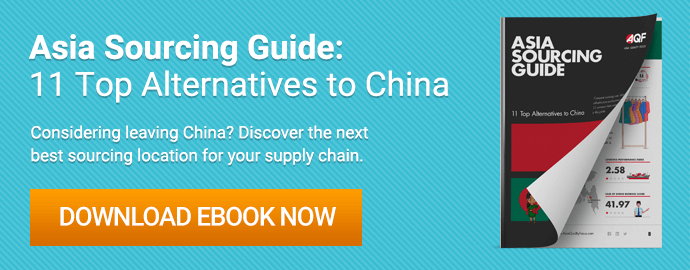[2021 Editor’s update to: https://www.intouch-quality.com/blog/top-5-sourcing-mistakes]
 Even with the proliferation of easy-to-use websites like Alibaba.com and LightIntheBox.com, sourcing products from China for your dropshipping or e-commerce business can be a daunting task. For this reason, many buyers forgo sourcing altogether and rely on agents or trading companies to do the legwork. Plus, these remote sourcing sites can be effective when used as part of a larger sourcing strategy, especially when you know how to spot red flags and avoid scams. So how can you protect yourself if you decide to take on your own sourcing projects?
Even with the proliferation of easy-to-use websites like Alibaba.com and LightIntheBox.com, sourcing products from China for your dropshipping or e-commerce business can be a daunting task. For this reason, many buyers forgo sourcing altogether and rely on agents or trading companies to do the legwork. Plus, these remote sourcing sites can be effective when used as part of a larger sourcing strategy, especially when you know how to spot red flags and avoid scams. So how can you protect yourself if you decide to take on your own sourcing projects?
Here are six common product sourcing mistakes and how to avoid them:
1) NOT SETTING QUALITY ASSURANCE EXPECTATIONS
It may seem counter-intuitive to address quality control right at the start of your sourcing project, but make no mistake—setting expectations for product quality before you start identifying suppliers in China is a crucial step. You will save yourself a lot of time and hassle if you use your quality guidelines as a way to narrow the field. In addition, we recommend creating a “Request for Quote” document or a QC Checklist that states which kinds of defects are unacceptable in your shipments.
2) PASSING ON PRODUCT SAMPLES
Though many trading companies require at least some factory ID verification, it’s easy to find misleading factory profiles. Do not be swayed by images of state-of-the-art manufacturing facilities. If they look like stock photos, they very well might be. The only way to truly test a factory’s actual capabilities is to either visit them in person (see factory audits), participate in a virtual factory tour, or examine product samples. When you’re in the early stages of your sourcing project, collecting samples and scrutinizing them for quality is the most feasible option. Next, you’ll want to establish an approved sample of your product—one that represents the gold standard to which all future products must match.
3) FORGOING INSPECTIONS
Even once you’ve conducted a factory audit, reviewed countless samples, and even have a QA-approved sample, you’ll still need to keep the factory honest. The unfortunate reality is that your actual shipment could vary significantly in quality from what you originally agreed on despite many assurances. Product inspections are your last defense against poor-quality products. So if you’ve placed an order with a supplier, plan on scheduling at least one product inspection before the products leave the factory. Doing so will give you an all-important chance to address any underlying quality issues before the order ships.
4) NOT ASKING FOR TRANSPARENCY
After establishing what your  supplier can deliver in terms of quality, it’s crucial to reduce your risks even further by calling for full transparency. Even when dealing with ultra-trustworthy manufacturers, it’s worth directly stating how much you value proactive communication. Of course, asking for transparency won’t get you ahead of every challenge. Still, it’s always easier to come up with an agile response when you have timely, relevant information from your manufacturer. While there will always be unforeseen factors to deal with, the COVID-19 pandemic has shown us that the direct-to-consumer brands with the strongest crisis communication skills are the ones staying competitive and profitable. Ideally, it’s your supplier who will initiate and bring helpful information forward. Examples might include getting news on regional restriction issues or recent changes to a sustainable supply chain.
supplier can deliver in terms of quality, it’s crucial to reduce your risks even further by calling for full transparency. Even when dealing with ultra-trustworthy manufacturers, it’s worth directly stating how much you value proactive communication. Of course, asking for transparency won’t get you ahead of every challenge. Still, it’s always easier to come up with an agile response when you have timely, relevant information from your manufacturer. While there will always be unforeseen factors to deal with, the COVID-19 pandemic has shown us that the direct-to-consumer brands with the strongest crisis communication skills are the ones staying competitive and profitable. Ideally, it’s your supplier who will initiate and bring helpful information forward. Examples might include getting news on regional restriction issues or recent changes to a sustainable supply chain.
5) THINKING THAT NO NEWS IS GOOD NEWS
If you’ve already established a dialogue with a factory and things seem to be going smoothly, you should still be hearing from them regularly. An excellent indicator of a reliable manufacturing partner is they constantly ask you questions, seek your input or approval, and generally keep you in the loop. If there is a lull in communication, it may not be a reason to panic, but it’s worth paying attention to. If the dialogue stalls for longer than you’re comfortable with, try to get in contact with the factory any way you can. While most Chinese suppliers are on the level, it is not unheard of for suppliers to simply vanish once an order is placed and paid for.
6) IGNORING YOUR GUT
Like with any important decision in business or life, you have to trust your gut. You may have noticed a common thread with each item on this list, and that is: always seek verification. Also, never take anything at face value. Sometimes you don’t even need to go through those two steps—if something doesn’t feel right, move on. Any number of things can just feel “off” about a supplier. Maybe they offer rock-bottom prices that undercut every competing offer you’ve received. Perhaps the products pictured on their website look a little too perfect—or they even show branded products you're confident they can't supply. Whatever it is, trust your instincts and walk away if you get the impression things just don’t add up.
Ready to simplify your quality control tasks? Let our experts explain how we can make your life easier with a 3P, total quality management strategy. Contact us today!







